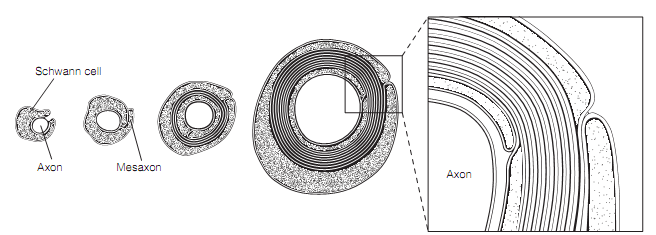Myelination
The Oligodendrocytes in the CNS and Schwann cells in the peripheral nervous system give the myelin sheath, an electrically insulating wrapper around most of the axons.
In the peripheral nervous system Schwann cells line up all along the axon, surrounding it with a pseudopodium-like structure that is the mesaxon. At this point for unmyelinated axons the procedure stops. For myelinated axons the mesaxon spirals about the axon some 8–12 times, ensheathing it with a series of concentric double layers of plasma membrane, as the cytoplasm gets left behind as shown in figure. Each Schwann cell myelinates between 0.15 and 1.5 mm of axon. Among adjacent ensheathed areas is a tiny (0.5 µm) gap of naked axon known as the node of Ranvier. At this point the axon membrane is directly exposed to the extracellular space. As peripheral nerve axons can be long, hundreds of Schwann cells may be required to myelinate them. The Myelinated nerve fiber diameters are between 3 -15 µm, but across this range the proportion of the diameter added by the myelin sheath is roughly constant.
The Myelination proceeds in a same way in the CNS except that each oligodendrocyte extends various processes therefore it can contribute to the myelination of various adjacent axons. Therefore fewer glial cells are required for the CNS myelination, saving space.

Figure: Myelination of a peripheral axon. The myelin sheath is created by the growth of the mesaxon that wraps itself around the axon. From Susan Standring (2008) Gray’s Anatomy: The Anatomical Basis of Clinical Practice, 40th ed. with the permission from Elsevier.